STEVE BERKMAN and TORY STOKES, NOV Downhole
The total available rig count for the U.S. continued to decline in 2012, even though activity strengthened, according to the 59th annual NOV Downhole Rig Census. Sliding commodity prices since last year did not seem to impact drilling momentum during this year’s census period in the early summer. While activity grew, the fleet continued to shrink, despite another large number of newly manufactured rigs that came online over the past year. This combination of increasing demand and declining supply further tightened U.S. rig utilization in 2012.
The Canadian market saw both rig availability and rig activity recede during the 2012 census period. A somewhat greater exodus of rigs occurred this year that outnumbered the uptick in new units built. Canada seemed to react more quickly to the lowered levels of oil and gas prices, as evidenced by the drop in drilling.
The global offshore mobile fleet experienced a different scenario altogether, with available rigs, as well as active rigs, climbing. Even more new units entered the worldwide fleet, and these rigs are gradually being put to work as the rebound continues after the U.S. moratorium.
NOV Downhole partners with several companies to pull together the industry statistics that are published in this article. IHS Drilling Data, RigData and ODS-Petrodata provide detailed information regarding the U.S. land and global offshore mobile rig fleets. The Canadian statistics are provided by NOV Downhole personnel in Calgary, along with Nickle’s Energy Group. The international land rig fleet numbers are collected and summarized annually by NOV Downhole regional managers.
CENSUS HIGHLIGHTS
Key statistics from the 2012 census include the following:
-
The U.S. rig fleet had a net decline of 75 units, causing the total available count to fall about 2%, to 3,006 units. This overall decrease is the result of 335 rig additions and 410 rig deletions occurring during the past year, Fig. 1.
-
A number of U.S. rigs, 386 units, were retired from active service over the past year.
-
Newly manufactured rigs were the largest addition to the fleet, numbering 223 units.
-
U.S. rigs meeting the census definition of “active” increased to 2,248, up 9%.
-
U.S. rig utilization (combined land and offshore) rose to 75%, up from 67% last year, Fig. 2.
-
The total number of U.S. rig owners dropped to 317, from 325 in 2011.
-
Drilling contractors continue to own 85% of all U.S. drilling rigs, with operators owning the remaining 15%.
-
The Canadian available rig fleet declined to 747 units, down 3% from last year.
-
Canadian rig activity also dropped 11%, with active rigs numbering 329.
-
Canadian utilization is now 44%, compared with 48% in 2011.
-
The global offshore mobile fleet’s available count came in at 824, after growing 4%.
-
Global offshore mobile activity was up 12%, with active rigs at 626 units.
-
Utilization for the global offshore mobile fleet is now 76%, up from 70% last year.
-
Most international regions showed increases in land utilization, with the average at 95% in 2012.
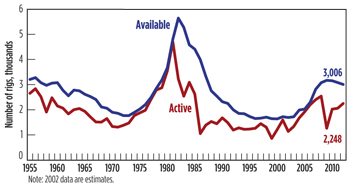 |
| Fig. 1. U.S. available vs. active rigs, 1955-2012 |
|
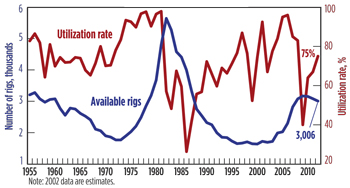 |
| Fig. 2. U.S. available rigs vs. utilization, 1955-2012 |
|
U.S. RIG ATTRITION ACCELERATES
Rigs are retired from the fleet every year for numerous reasons. Some units of older technology have sat idle for so long, that they are considered unavailable, since they would require a significant capital expenditure to be operable. Often, these units are even missing equipment or a stand-by crew. Occasionally, accidents also damage rigs beyond repair, and these units are no longer counted in the census. Furthermore, rigs are sometimes sent out of the U.S. to other countries for more lucrative jobs. Each of these cases is tallied in the annual census as a reduction to the U.S. fleet. This year’s total deletions numbered 410, about 23% higher than last year’s reduction of 334 units. As mentioned, deletions to the fleet are categorized three ways, Table 1:
| Table 1. Changes in the available U.S. fleet (click table to enlarge) |
|

|
Rigs in the “removed from service” category continue to be the largest group of deletions, rising to 386 units in 2012, versus 315 last year. Included in this category are any units that require a large capital outlay to be operable, have been auctioned for parts or cannibalized to keep other rigs running, or have been stacked for a long period of time. Some of these older rigs, however, may be refurbished later and brought back into service, if drilling conditions warrant the expense. In that case, they are added back to the available fleet during the census year in which that occurs. With activity on the increase, a number of reactivations have happened during the past several years. These rigs are mentioned in the “additions” part of this article. However, as the U.S. fleet continues its transformation, with many brand new units coming online, the need for these older units may begin to diminish.
Depending on the current market situation, companies will sometimes move their rigs into and out of the U.S., and these rig movements are noted in the census each year. In this year’s count, 23 rigs moved out of the U.S., an increase from the 16 units that left in 2011. Canada was the destination for more than half of the relocations. Rig movement into the U.S. is covered below.
Rigs that were destroyed, or damaged beyond repair, are in the final deletions category. Just one rig, a land unit downed by a tornado, fell into this category for the 2012 census. This compares with three rigs that were destroyed last year.
U.S. RIG ADDITIONS GROW
The average age of rigs in the U.S. fleet continues to decline, as newbuilds keep entering the fleet. Rig expansion programs are still going strong, with a significant rise noted in this year’s census. Some companies also find that assembling new rigs from used components, or refurbishing older units, can be cost-effective. Several rigs are also typically added, as they move from other countries into the U.S. Census figures show that the U.S. fleet added 335 rigs, overall, during the past year, up 28% from the 262 added in 2011. Although rig additions climbed significantly this year, these 335 units did not completely offset the 410 deletions. Fleet additions fall into one of four categories, Table 1:
-
Newly manufactured rigs
-
Rigs brought back into service
-
Rigs moved into the country
-
Rigs assembled from parts
Apparently, there is no immediate end in sight for the influx of new rigs that has continued for several years. Just during the past seven years, newly manufactured rigs totaling 1,538 units have been added. This puts more than 50% of the fleet at less than seven years old, offering the advantage of newer technology and lower maintenance costs. Of those 1,538 rigs, 223 were added just during this year’s census. This is an increase from the 158 added in 2011.
The number of U.S. rigs that were reactivated in 2012 was essentially the same as last year, coming in at 94 units versus 95 in 2011. Each of these rigs that was reactivated had been counted previously in a prior census, but had been removed, due to the census rules of governing inactivity or inoperability. These 94 units have now resurfaced as refurbishments or reactivations, and are being counted again as part of the U.S. available fleet.
Cited in the annual census are also rigs that moved into the U.S. during the past year. Twelve rigs were brought into the U.S. over the past year, almost all of them land rigs coming from Canada. This is twice the number that was counted as moving into the country last year. With 23 rigs moving out of the country, and just 12 moving in, a net decline of 11 units was counted from overall rig movements. There has been a tendency over the past several years for more rigs to leave the U.S. than enter.
Lastly, six rigs assembled from component parts were added to the fleet in 2012. This is double last year’s three units that were included. This is typically a number that is difficult to quantify, since there is often a fine line between refurbishments and new assemblies, especially when rigs have new owners and are, therefore, subsequently renamed. Although we suspect that there may be more units that could be classified in this category, it is clear that in recent years, many more rigs have been newly manufactured or refurbished than have been assembled from component parts.
Total rig additions numbered 335, while deletions totaled 410. The net change in the fleet over the past year was a 75-unit decrease, down another 2%. Although this decline shows an increase in rig retirements, it also indicates a fleet touting hi-tech advantages like never before, Fig. 3.
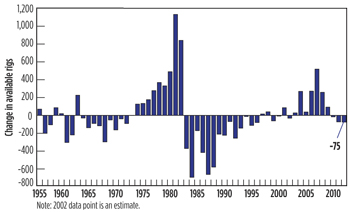 |
| Fig. 3. U.S. change in available rigs, 1956-2012 |
|
CANADIAN FLEET DOWNSIZES
Data for Canada are supplied by annual rig reports from Nickle’s Energy Group, as well as supplemental information provided by NOV Downhole personnel. The Canadian available fleet began experiencing declines about two years ago. A significant number of rigs continue to be dropped from the Canadian census as they retire from service, sit idle for extended periods, or are moved out of the country.
The principal cause of Canadian fleet attrition this year was rigs removed from service. Data gathered about these rigs indicated that 67 units were no longer considered operational, possibly due to the condition of the rigs, as well as the time the units have been sitting idle. This is just a few rigs more than the 63 units removed last year. The bigger story this year may be the 33 rigs that were counted as exiting Canada over the past 12 months. This was a significant increase over the 11 rigs that departed the country in the 2011 census. Most of these were land rigs, indicated as heading for the U.S. Thankfully, no units were reported as destroyed over the past year. The sum of all deletions totaled 100 units in 2012.
The number of newly manufactured rigs entering the fleet has been dropping off in Canada, but it did have a resurgence this year, with 35 built-from-scratch rigs added. This compares with just eight new rigs included in 2011. Reactivated rigs were almost as strong as newbuilds, with another 34 refurbished units added in Canada. This trend has been about the same for the previous two years. There were also four units that moved into the country for 2012. This makes the net decline in imports/exports 29 units after considering the 33 rigs that moved out of Canada. No units were indicated as assembled from component parts. Total rig additions came to 73 units, overall, for Canada, 20 units higher than last year. Although a significant number of rigs was added through reactivation and building, additions didn’t overcome reductions in 2012. The available count fell 27 rigs, or 3%, Table 2.
| Table 2. Changes to the Canadian rig fleet (click table to enlarge) |
|

|
GLOBAL OFFSHORE MOBILE FLEET EXPANDS
Rig-building continues to swell the size of the global offshore mobile fleet. Another 44 new rigs came online over the past year and were counted in this year’s census. For the past four years, at least 40 new units have been added to the fleet, with the 2011 census seeing 47 brand-new rigs. In addition to these newbuilds, four offshore rigs were also brought back into service this year, and two units were added after being assembled from component parts. ODS-Petrodata, which provided most of the offshore census data, reports that another 65 units are scheduled for worldwide delivery by the end of the 2013 census, which will be taken early next summer. Even though some rigs may not meet that schedule, another strong year of fleet additions is likely, probably topping the number of brand new units seen this year.
The global offshore mobile fleet experienced slightly higher attrition this year and includes 18 rigs that have been retired from service, some of which are undergoing conversions to non-drilling. This is more than double the number counted last year, when just seven rigs were removed from the fleet. Two offshore units were reported as destroyed due to accidents, one due to a fire and one to a storm, Table 3. Note that if an offshore rig has not worked for more than five years, and does not have upcoming contracts, it is generally not classified as available. This is to prevent rigs that require significant capital and maintenance time from being counted. Although these drilling units are not included as “available” by census rules, it is common for some to be reactivated later, if market conditions warrant. Although the U.S. census is able to track the majority of platform and inland barge rigs in this country, the global mobile offshore statistics do not reflect these units, since the worldwide statistics are particularly difficult to obtain.
| Table 3. Changes to the global offshore mobile fleet (click table to enlarge) |
|

|
The available count for global offshore mobile units is now 824, a net increase of 30 rigs. This is a 4% jump from the 794 rigs in the last census. The worldwide offshore fleet is widely distributed, with the Middle East slightly in the lead, followed closely by Southeast Asia, South America and the U.S., Fig. 4. The fleet composition by specific rig type is shown in Fig. 5.
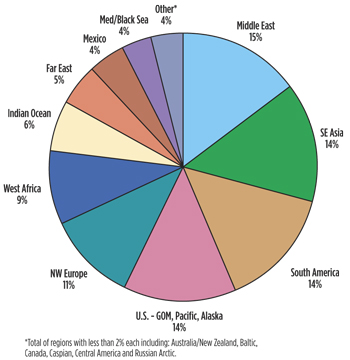 |
| Fig. 4. 2012 Global offshore mobile fleet by region |
|
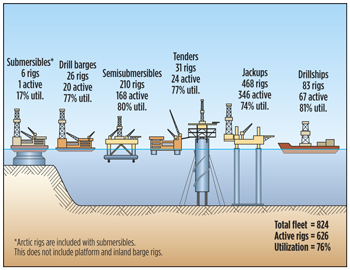 |
| Fig. 5. Makeup of the global offshore mobile fleet in 2012. |
|
U.S. ACTIVITY SWELLS
U.S. drilling activity has been climbing for the past several years, and figures for 2012 show another significant increase. Market forces helped put more rigs back to work this year, and the active count rose another 9%. Active rigs numbered 2,248 for 2012, versus 2,059 last year. The uptick in activity, compared to the decline in availability, shows a tightening market. This is one indication that rig rates may continue to climb.
The methodology used to count active rigs for the NOV Downhole census varies from most other quoted rig counts. This census counts a rig as active, if it has “turned to the right” at any time during a defined 45-day period in the spring, this year between May 9 and June 22. Other active counts examine smaller time periods such as a week. When a longer period is used to monitor activity, such as the NOV Downhole census uses, a larger pool of working rigs will be counted, and the statistic will usually be higher.
An often-quoted industry marker is rig utilization, the ratio of active to available rigs. This number is useful for giving a snapshot of the demand/supply balance at a particular time. As the utilization percentage rises, it can indicate a more healthy industry. This year, utilization has climbed further and is now 75%, versus last year’s 67%. Just a few years ago in 2009, this statistic was at a disappointing 40%. This year’s improvement brings the number to slightly above the 59-year historical average of 74%, a heartening sign.
There were 758 available U.S. rigs that were not working during this year’s 45-day census period. These units may have been stacked for various reasons, such as being moved to their next drilling locations or lacking contracts, but they still were counted as available under rig census rules. The inactive rigs were classified according to the length of time they have been idle. Rigs stacked less than one year numbered 525; one to two years, 135; and two to three years, 98. Census rules state that any rig stacked for longer than three years will be removed from the available fleet. However, rigs are often retired before their stacked status targets them for deletion. Rigs that fall into this category, and are removed from the fleet because they are no longer economically viable, fall into the group, “removed from service.” There was an abundance of rigs counted in the 2011 census that had been stacked more than two years, and, consequently, they were removed from service this year.
Another statistic, full-year utilization, is the total percentage of available rigs that drilled at any time during the past year. This is one other way to gauge the overall fleet dynamics, and it gives a slightly different picture of activity. Adding the 2,248 active rigs to the 525 rigs stacked less than one year provides the total number of rigs that drilled during the past year. This full-year utilization figure indicates that rig owners used 2,773 units, or 92% of all available rigs, compared with 85% last year. This statistic has been climbing for the past several years and has now risen to over 90%. This level may indicate that the demand/supply balance is at an improved state, with fewer marginal rigs left in the fleet.
For 2012, results by region were varied, with most areas experiencing increases in rig activity. The regional breakdown, which compares this year’s numbers to 2011’s figures, is shown in Table 4. The rig count in the ArkLaTex region has dropped dramatically over the past two years, and is now just 151 rigs after being 229 last year and 389 in 2010.
| Table 4. U.S. regional census results (click table to enlarge) |
|

|
The other region that experienced a significant decline was the Northeast States. Regional activity in the Northeast went from 218 units in 2011 to 191 this year.
Utilization by region also shows mixed results, with most areas going up, but two went down. This year’s utilization figures for each region are as follows:
-
Alaska, 65%
-
Northern Rockies, 82%
-
Southern Rockies, 79%
-
Northeast States, 56%
-
Permian Basin, 85%
-
Gulf Coast, 77%
-
ArkLaTex, 69%
-
California, 73%
-
Southeast States, 58%
-
Mid-Continent, 79%.
The previous figures are a combination of land and offshore statistics, but for U.S. land rigs, alone, gross utilization came in at 76%. This is an increase from 68% in 2011, Fig. 6, Table 5. The U.S. marine fleet also experienced a boost in utilization, up to 52%, overall, in 2012, compared with 43% in 2011. Demand varies significantly by rig type, with inland barges and floating rigs both in greatest demand at 68%, and offshore platform rigs having the lowest utilization at just 23%.
| Table 5. U.S. land rig counts and utilization |
|
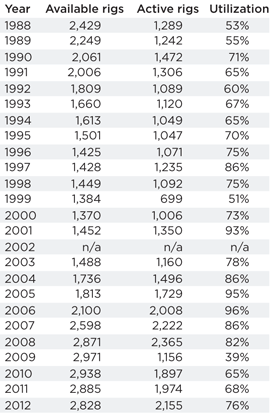
|
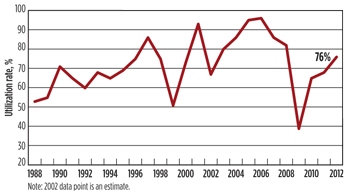 |
| Fig. 6. U.S. land rig utilization, 1988-2012 |
|
The total U.S. rig fleet, both land and offshore, is also broken down by depth capacity. Large differences exist between rigs in these depth ranges. The rigs with the highest utilization, 89%, continue to be those in the 16,000-to-19,999-ft range. Those with the lowest utilization were the most shallow units (3,000 to 5,999 ft), at just 51%. Rigs in the over-20,000-ft category experienced the largest change, rising to 74% utilization this year after achieving 57% in 2011. Even at the higher, overall level of utilization, some of the market areas still have some excess capacity, Table 6.
| Table 6. U.S. rig utilization by depth capacity (click table to enlarge) |
|
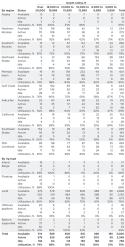
|
CANADIAN ACTIVITY FALLS
Canada experienced a decline in rig activity over the past year. Canadian figures have experienced some wide swings since the census began tracking them in 2005. For several years, there had been some market volatility, but it had lessened, and activity numbers have more recently been in the low-to-mid-300s. The active count dropped about 11% over the past year, down to 329 units. This was almost a return to where it was in 2010 after increasing 10% in 2011. With both available rigs and active rigs declining by about the same percentage, Canadian utilization figures fell somewhat in 2012. Utilization has dropped to 44% from 48% last year. Swings in Canadian utilization over the past several years have been noteworthy, with a low of 22% in 2009 just a few years after a high of 84% in 2006, Fig. 7.
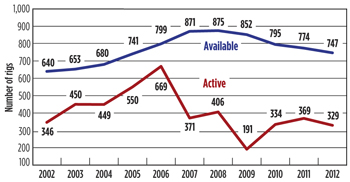 |
| Fig. 7. Canada available vs. active rigs, 2002-2012 |
|
Regarding Canadian drilling capacity, almost 40% of Canada’s rigs are in the 6,000-to-9,999-ft category. Fleet utilization by depth capacity shows that demand is now highest in the >20,000-ft range (57%), although the fewest number of rigs is in that category. The lowest utilization, 39%, is in the 10,000-to-15,999-ft range, Fig. 8.
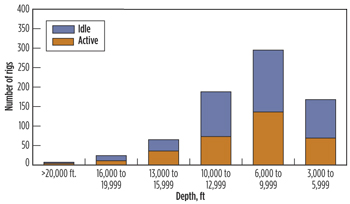 |
| Fig. 8. Canadian rigs by depth capacity, 2012 |
|
INTERNATIONAL LAND RIG UTILIZATION RISES
Rig utilization for the primary international areas has been tracked since 2006. For 2012, almost all areas showed strengthening markets and higher utilization figures. The exceptions were Asia (including China) which was flat, and Latin America, where idle rigs in Colombia and Argentina caused utilization to fall. In Africa, the return of rig activity in Libya after the previous shutdown boosted the utilization figure there. European utilization climbed, due to momentum in the UK and Russia. Note that some international areas have large numbers of available rigs, but these units are typically of older technology and may not be universally mobile or marketable. Also, in some cases, available rigs are actually under contract awaiting a project start, and are realistically unavailable for other work, Table 7.
| Table 7. International land rig utilization (click table to enlarge) |
|

|
GLOBAL OFFSHORE MOBILE FLEET MORE ACTIVE
During the active census period for 2012 (May 9 to June 22), the global offshore mobile fleet showed a considerable boost in activity, and the active count climbed to over 600 units. Total working rigs were up to 626, an increase of 12%. This is the highest number of active rigs recorded in census figures, since the global offshore mobile numbers started being included in the census in 2001. This compares to an active count in 2011 of 559. All offshore mobile units, with the exception of platform and inland barge rigs, are included in these statistics. With active rigs climbing, utilization was pushed up to 76% for the offshore mobile fleet, Fig. 9.
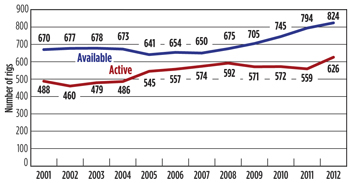 |
| Fig. 9. Global offshore mobile available vs. active rigs, 2001-2012 |
|
U.S. INDUSTRY TRENDS
In addition to looking at individual rigs, the census also counts the number of companies that own the rigs. After experiencing increases since 2003, the number of rig owners in the drilling business has essentially leveled for the last few years, with the number of new drilling companies added balancing closely with the number of companies ceasing operations. For 2012, the net number of rig owners declined slightly, by eight companies, to be 317.
Drilling contractors have always owned considerably more drilling rigs than operators. The percentage of operator-owned rigs has inched up over the last several years, but this year, the split has remained essentially the same. Operators continue to own about 15% of the fleet, or 439 rigs, compared with 2,567 units owned by drilling contractors.
Another way to observe rig ownership in the U.S. is by examining the fleet sizes of individual companies and how this trend has moved over the years. These statistics have been compared since 1993, when consolidation was on the upswing. The larger companies (those with more than 20 rigs) continue to hold the largest percentage of the fleet, this year about 57%. This percentage is actually down about four points from last year. Gainers, percentage-wise, are the companies with rig holdings in the 11-to-20-unit range that went from owning about 12% of all rigs to owning 16% of the fleet.
CONTRACTORS CONCERNED ABOUT CREW AVAILABILITY
NOV Downhole sends out an annual survey to drilling contractors, inviting them to share their opinions about the state of the industry and their current business conditions. These professionals graciously take the time to give valuable insight regarding their viewpoints, industry concerns and future projections. The 2012 survey was completed by 58 contractors, or more than 18% of all U.S. rig owners. These contractors come from a wide variety of company sizes and regional areas.
In the survey, rig owners are asked every year to rank a list of key issues that are typically of concern. “Crew availability” is often the most critical concern of contractors, and, again, this year it has risen to be the number one concern. With the ups and downs of the drilling market, it becomes difficult to hire and maintain a qualified workforce, especially when rig activity is on the rise. It is also challenging to find and keep employees willing to work in the more remote areas, where drilling jobs are now often the norm. Another issue usually ranked high by contractors is that of “rig rates,” which came in as the #2 concern this year after switching places with “crew availability.” Although the gap between rig demand and supply is shrinking, sometimes rig rates are slow to catch up, and contractors tell us there is still room for improvement. “Government regulations,” another key issue, was again rated #3. The upcoming election and uncertainty about future government intervention continues to concern contractors, and may be causing them to defer some projects or programs.
Respondents are also asked to share some of their company’s current business data. A figure that continues to increase, labor rates, has gone up, on average, another 8% over the past year. This notable rise is tied to contractors’ concerns about “crew availability.” Quality crews are not only harder to find, but they are increasingly more expensive, as well, when insurance and benefits are factored in. Another increasing expense for contractors is that of equipment maintenance and repair. On average, contractors will spend 9% more in maintenance this year than in 2011. Repair costs for older rigs can cause a company to discard or dismantle those units.
Contractors responding to the survey indicated that their rig activity has gone up 9% on average for 2012. This number is consistent with the overall activity increase seen in the census figures this year. For land rigs specifically, the average for respondents was about 7% higher than last year. We suspect that much of the increase in activity over the past several years is due to the shale drilling boom. However, most contractors have told us that they are expecting more modest improvements in the next year, probably in the 3% range.
A new question added to the survey this year encouraged contractors to tell us what new products or service developments will impact them most during the next two years. Answers varied widely, but several respondents each mentioned drill bits, specifically PDCs. A few other participants pointed to an increase in AC technology. Contractors were also asked to tell us the greatest business challenge that they may face during the next two years. Answers were mixed, as well, but some of the most common answers were maintaining qualified labor, the instability of commodity prices, and the regulatory and economic environment.
CONTRACTORS PLAN TO EXPAND FLEETS
Optimism is fairly evident when looking at the future plans of many contractors responding to the 2012 survey. Growth strategies appear to be common for many of these companies. When asked to describe their company’s plans for the next five years, the largest percentage of survey respondents, 45%, have plans to expand their current fleets. The second largest group, 28%, has no plans for change during the next several years, while 12% are seeking merger opportunities. Fewer companies mentioned diversification (10%), unknown plans (10%), pursuing international opportunities (9%) or downsizing (0%). Note that contractors were allowed to choose more than one category, so percentages will not total 100%.
U.S. FORECAST FOR 2013
New rig rollouts and retirements will continue, although at a somewhat diminished rate from the accelerated pace seen recently. NOV Downhole predicts that the available count will inch up only slightly by mid-2013. Furthermore, even though contractors remain optimistic, the current economic situation may keep drilling activity from climbing significantly, as active rig counts have begun to drop to some extent. In this softening market, rig utilization would fall slightly as well. Regardless, this setback may just be a bump in the road, if activity levels swell again in late 2013. 
|
CENSUS GROUND RULES
- Company sales regions were used for the geographical breakdown shown in Table 4 and the accompanying map.
- Contractor-owned rigs are those belonging to companies whose primary business is offering drilling contracting services.
- To be considered active, a rig must be drilling at least one day during the 45-day qualification period.
- Only workable rotary rigs are included; cable tool rigs are excluded.
- To be considered available, a rig must be able to go to work without requiring a significant capital expenditure.
- Rotary rigs stacked for an extended period of time, typically three years or longer, are not counted as available.
- A rig must be capable of, and normally employed for, drilling deeper than 3,000 ft. Therefore, some shallow drilling rigs (mostly in the Northeast) are excluded, but this is necessary to ensure that well-servicing rigs are not counted.
- Electric rigs include all those that transmit power from prime movers to electrically driven equipment.
- Inland barges include barge-mounted rigs that may be moved from one location to another via canal, bayou or river, and drill in sheltered inland waters. Offshore rigs include stationary platform units (both self-contained and tender-supported), bottom-supported mobile units, and floating rigs (both drillships and semisubmersibles).
|
ACKNOWLEDGEMENTS
The following are recognized for their contributions to this year’s rig census: IHS; RigData; Tom Kellock (ODS–Petrodata); Renee Porter (Nickle’s Energy Group); Robert Breit, Leonora Compton, Wade Dannhaus, Kosay El-Rayes, Ana Martel, Laura Pasveer, Randall Shapland, Lee Tompkins (NOV Downhole).
|
The authors
STEVE BERKMAN is the director of Asset Optimization for NOV Downhole. Previous positions held for the company include director of Strategic Marketing (NOV Downhole), Marketing manager (ReedHycalog) and Regional Sales manager in Latin America (Reed Hycalog). He began his career with ReedHycalog over 30 years ago, starting as a design engineer in 1982. Mr. Berkman has been all over the world in various engineering and sales positions. He received a BS degree in mechanical engineering from the University of Texas in 1981.
TORY A. STOKES is a consultant for NOV Downhole, after being employed by ReedHycalog as senior marketing analyst for eight years. She graduated with a BS degree in applied mathematics from Texas A&M University in 1985, and earned an MBA from the University of Houston in 1993. |
|


















